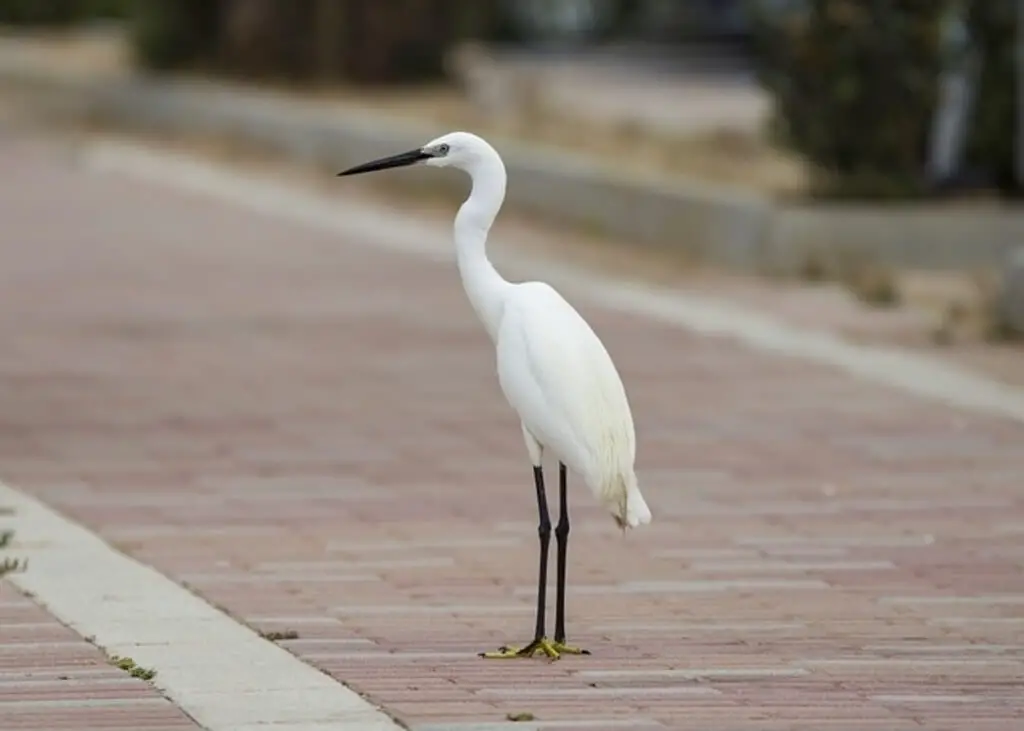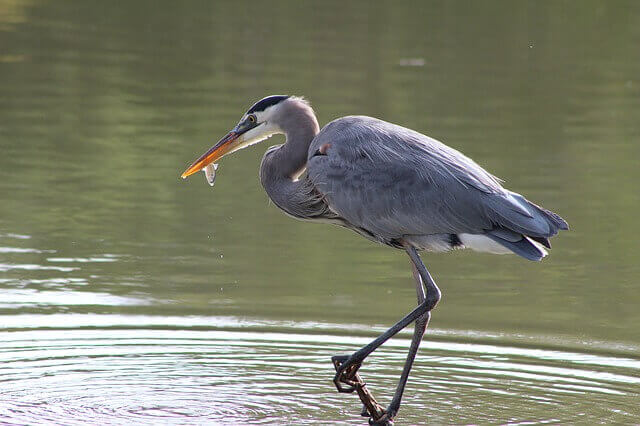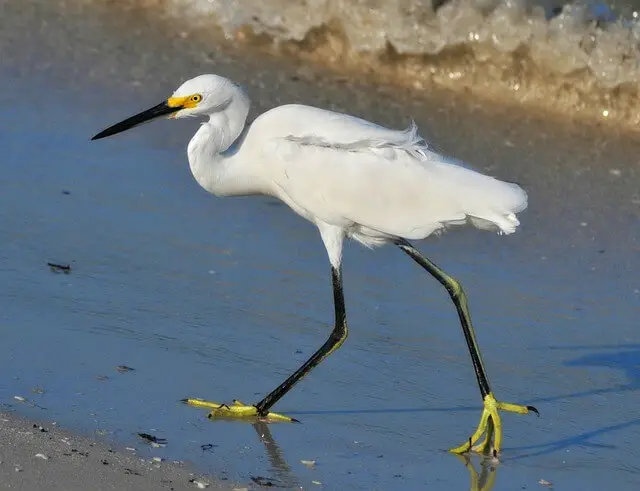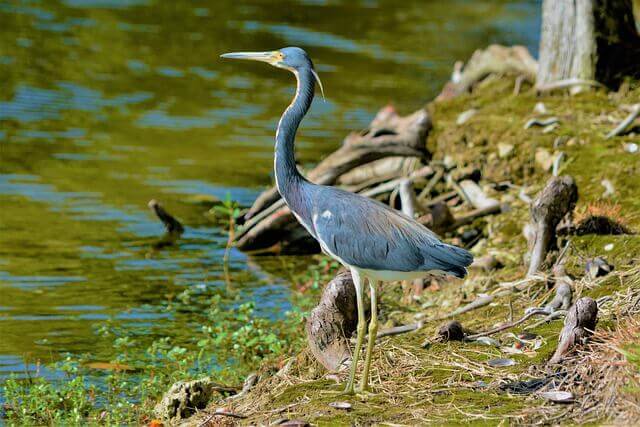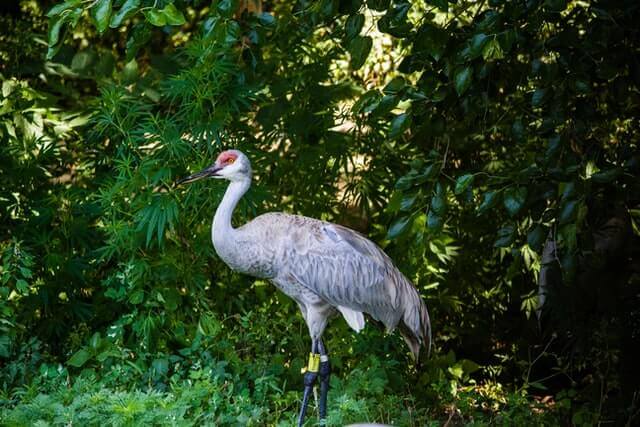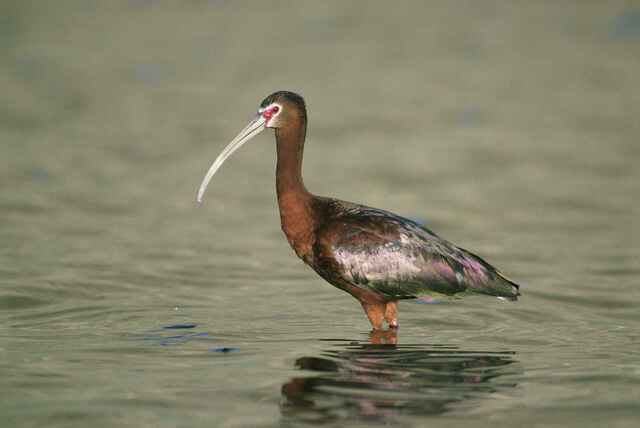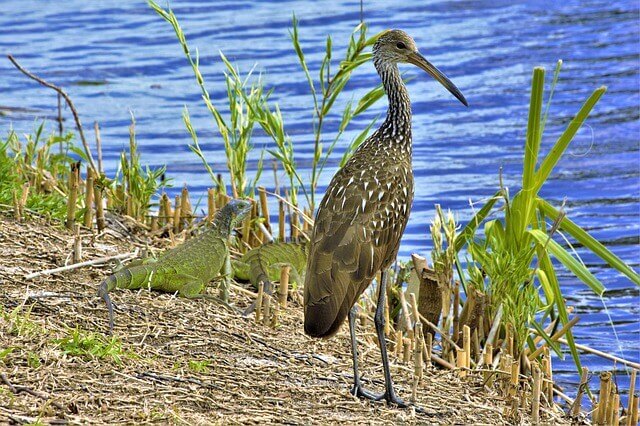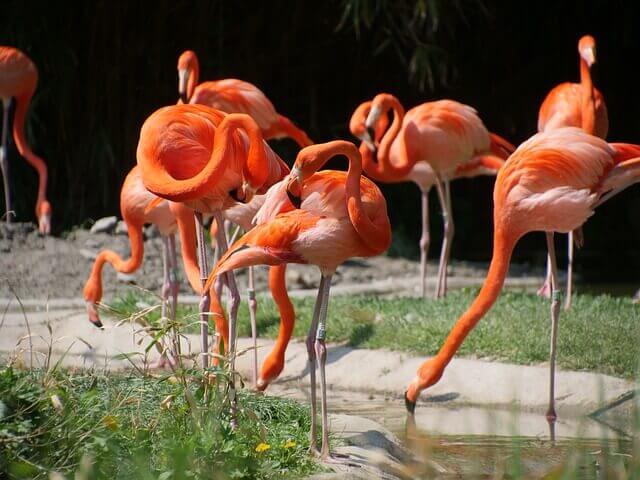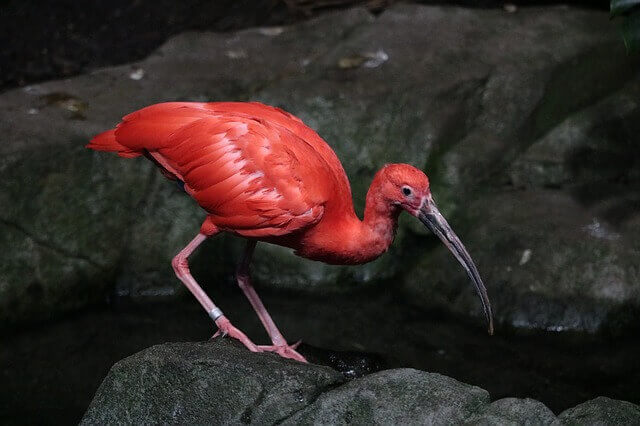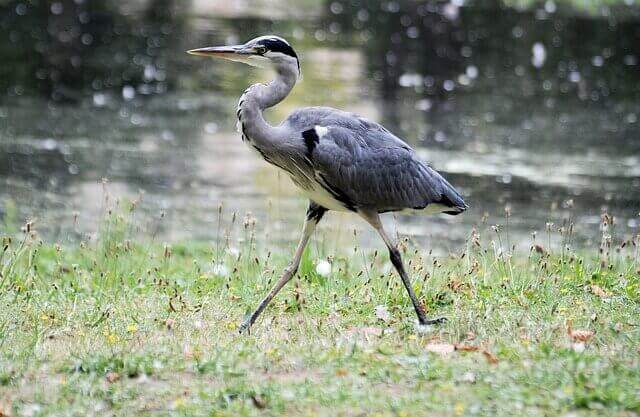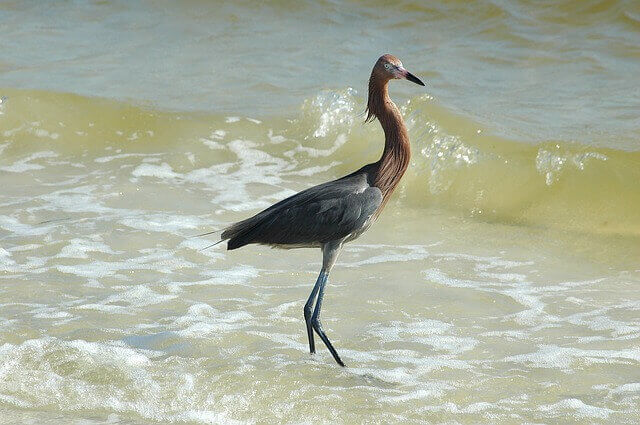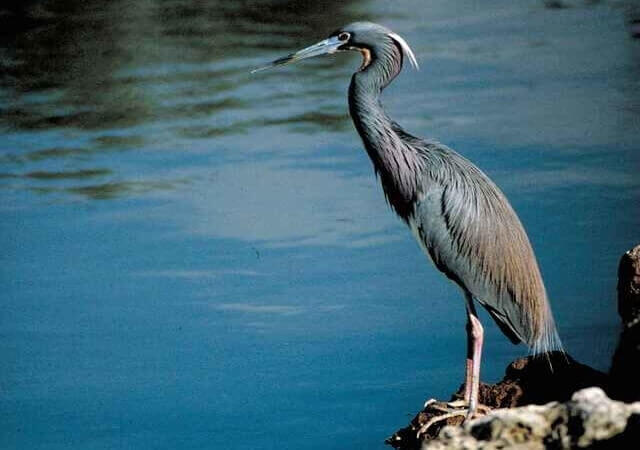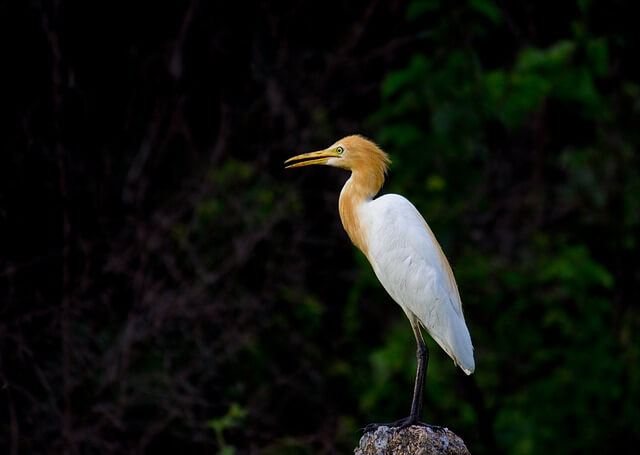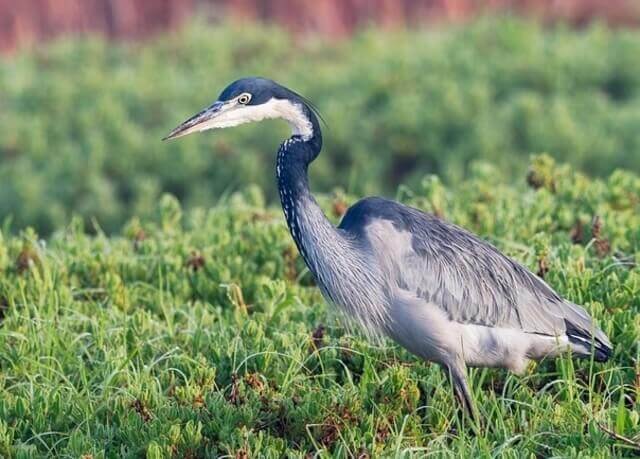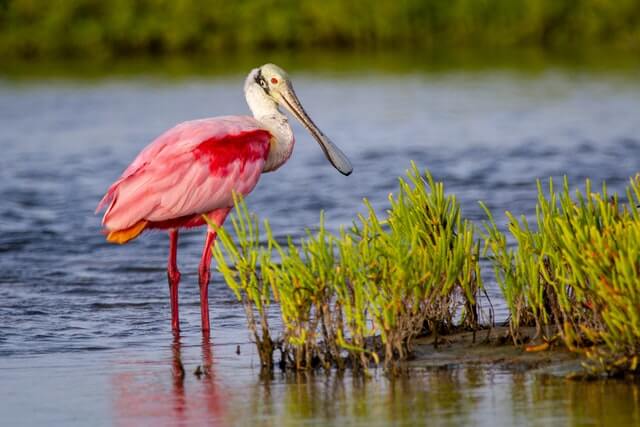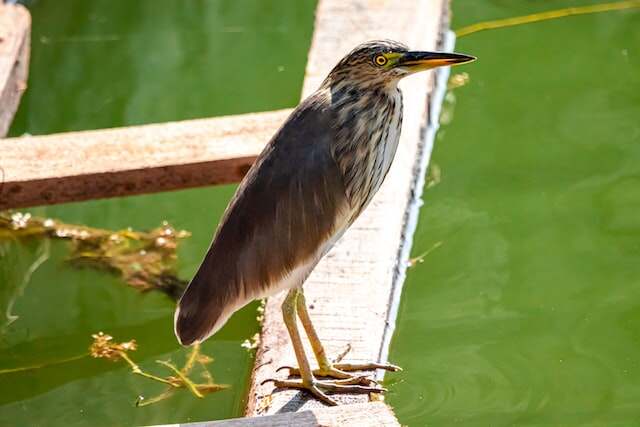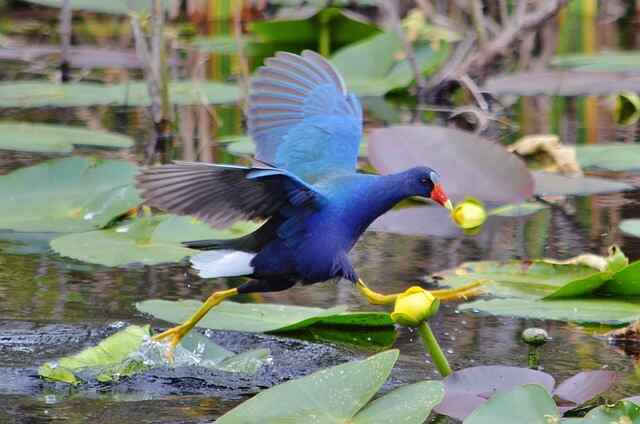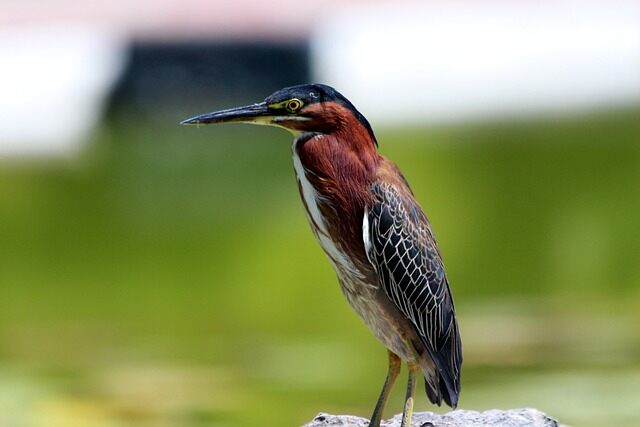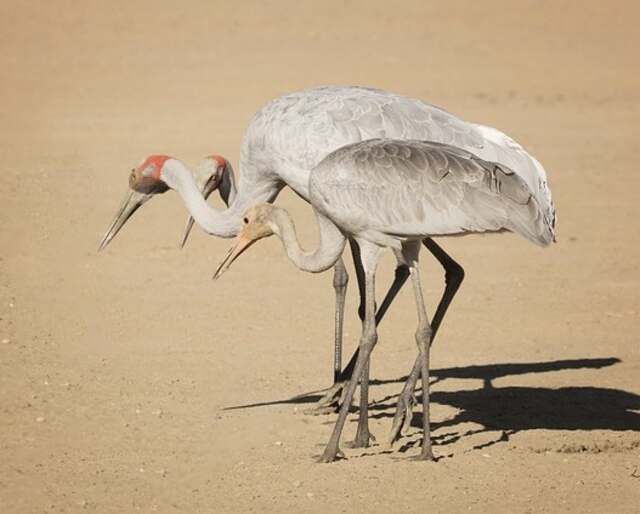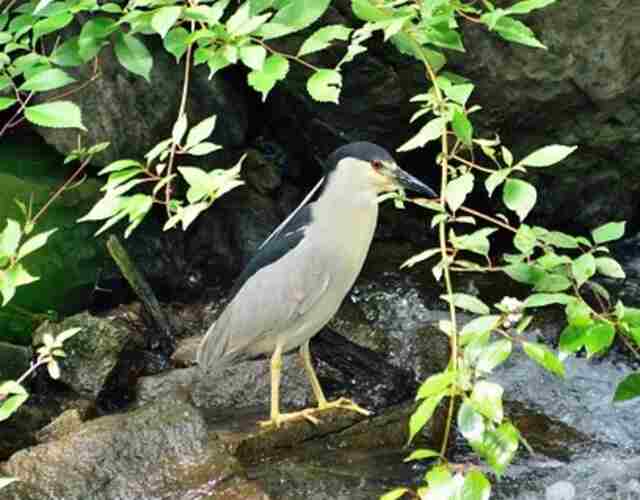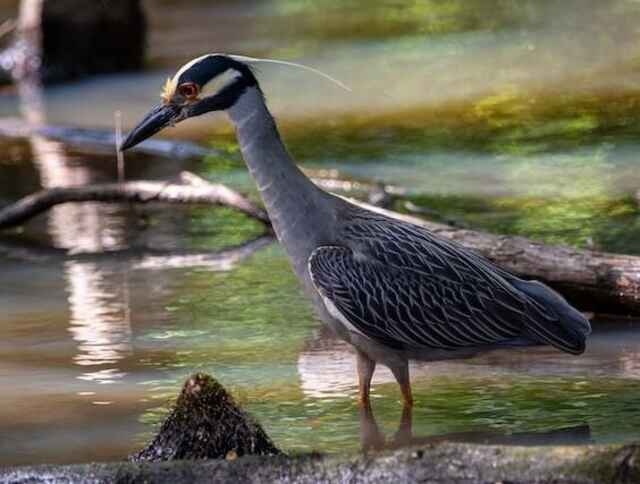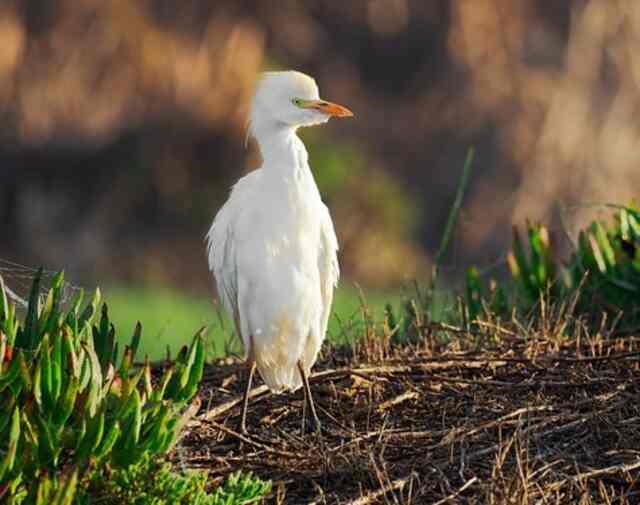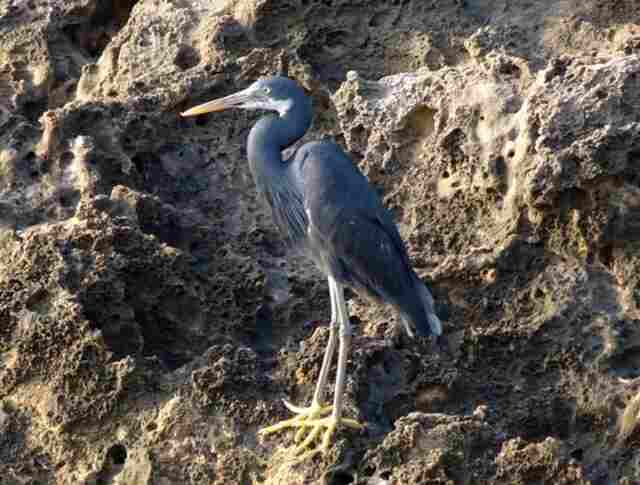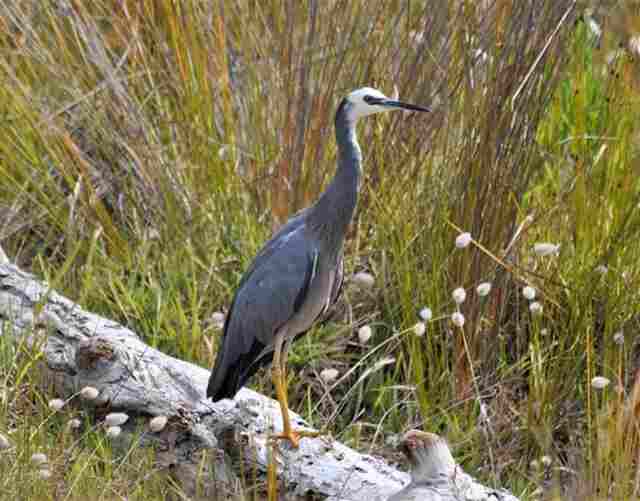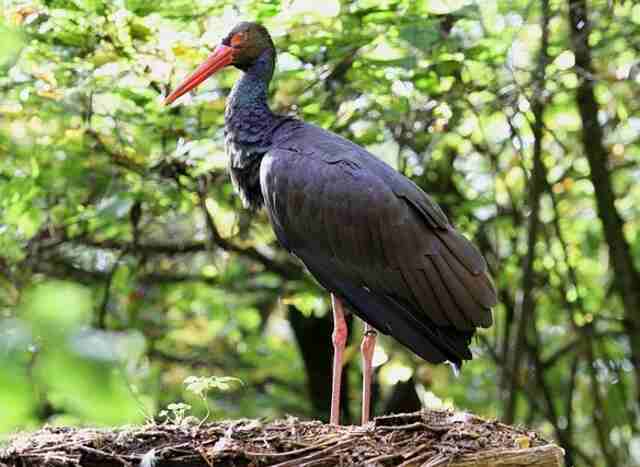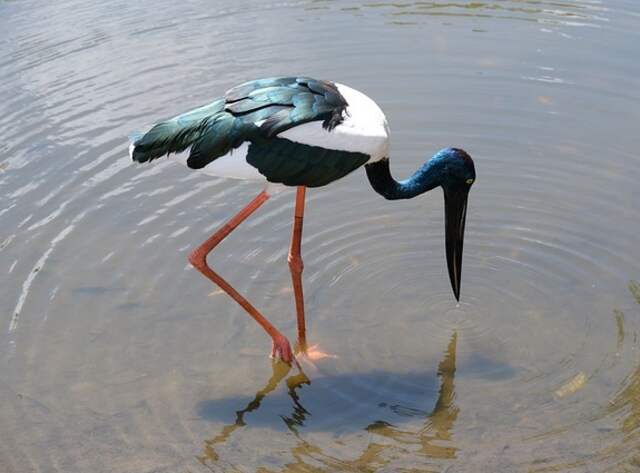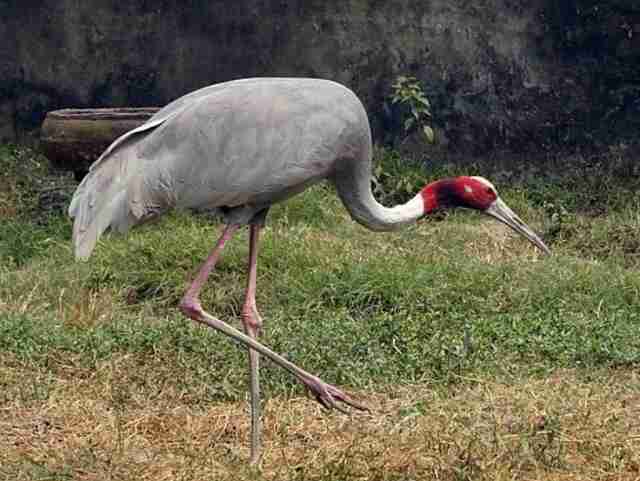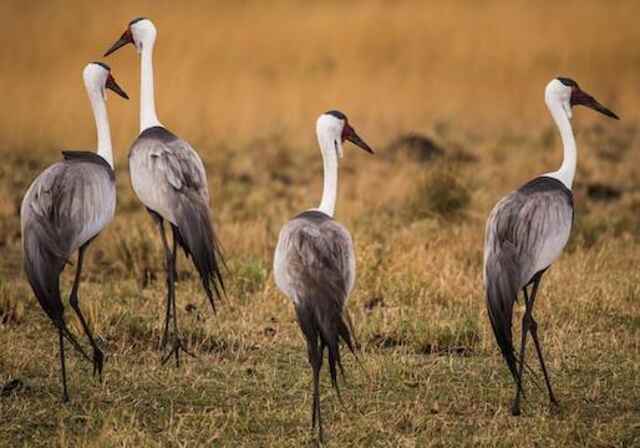Are you fascinated by the beauty and grace of birds? Do you find yourself captivated by the sight of long-legged and long-necked birds? If so, you’re in for a treat! In this article, we’ve compiled a list of 32 stunning birds with long necks and legs, each boasting its unique beauty and elegance.
From the vibrant Green Heron to the towering Great Blue Heron, each of these bird species is a true marvel of nature. So, join us on a journey through the intricate world of long-necked and long-legged birds and discover some of the most stunning feathered friends you’ve ever seen.
Table of Contents
- 1 Types of Birds with Long Necks and Legs
- 1.1 Great Egret
- 1.2 Great Blue Heron
- 1.3 Snowy Egret
- 1.4 Tricolored Heron
- 1.5 Whooping Crane
- 1.6 White-faced Ibis
- 1.7 Limpkin
- 1.8 American Flamingo
- 1.9 Scarlet Ibis
- 1.10 Gray Heron
- 1.11 Purple Heron
- 1.12 Red Egret
- 1.13 Sandhill Crane
- 1.14 Little Blue Heron
- 1.15 Jabiru
- 1.16 Cattle Egret
- 1.17 Black-headed Heron
- 1.18 Roseate Spoonbill
- 1.19 Stork
- 1.20 American Bittern
- 1.21 Purple Gallinule
- 1.22 Green Heron
- 1.23 Brolga
- 1.24 Black-crowned Night Heron
- 1.25 Yellow-crowned Night Heron
- 1.26 Intermediate Egret
- 1.27 Western Reef Heron
- 1.28 White-faced Heron
- 1.29 Black Stork
- 1.30 Black-necked Stork
- 1.31 Sarus Crane
- 1.32 Wattled Crane
- 2 Habitat and Distribution
- 3 Physical Characteristics
- 4 Behavior and Social Life
- 5 Threats and Conservation
- 6 Conclusion
- 7 FAQs
- 7.1 Which is the bird that has a long neck?
- 7.2 What’s a white bird with long neck?
- 7.3 What’s a white bird with long legs?
- 7.4 What’s a grey bird with long neck?
- 7.5 What’s a small bird with long neck?
- 7.6 Which is the pink bird with long legs?
- 7.7 What’s a brown bird with long neck?
- 7.8 Which is the bird with longest neck?
- 7.9 Is there a black bird with long neck?
- 7.10 What are long-necked birds?
- 7.11 What are long-legged birds?
- 7.12 Can you list some bird species with both long legs and long necks?
- 7.13 Which bird has a long neck and beak?
- 7.14 What is the name of the bird with a long neck in India?
- 7.15 Can you tell me about long-necked shorebirds?
- 7.16 Can you describe a bird with a long neck?
- 7.17 Do you know the names of birds with long necks?
- 7.18 Are there white birds with long legs and long necks?
- 8 Author
Types of Birds with Long Necks and Legs
Great Egret
| Length (feet) | Weight (lbs) | Wingspan (feet) |
|---|---|---|
| 3.1-3.4 feet | 1.5-3.2 lbs | 4.3-4.8 feet |
The Great Egret is a stunning bird with long necks and legs. Its elegant white feathers, yellow bill, and black legs make it a beautiful sight to behold. This majestic waterbird is found throughout much of the world in shallow wetlands, marshes, lakes, rivers, and estuaries. It feeds on fish and other aquatic animals, such as frogs and small crustaceans.
The Great Egret stands out from other birds because of its long neck, which allows it to search for food in deeper waters than most land birds can reach. In addition to its fishing skills, this graceful bird also has an excellent flying capacity that enables it to travel great distances across the globe. Thanks to conservation efforts, the population of these magnificent creatures is slowly increasing each year.
Great Blue Heron
| Length (feet) | Weight (pounds) | Wingspan (feet) |
|---|---|---|
| 3.0-4.5 feet | 4.5-5.5 pounds | 5.5-6.5 feet |
Great Blue Herons are tall, majestic birds that can be found all over North America. They have a blue-gray body with long wings and an elongated neck. The males usually have the same coloration as females, but they are typically larger than females and have longer feathers on their heads called plumes.
These herons usually live in wetlands, which is why they can often be seen hunting for fish at the edge of ponds or lakes. The diet of Great Blue Heron includes insects, frogs, mice, snakes, salamanders, and small crustaceans like shrimp and crayfish.
Snowy Egret
| Length (feet) | Weight (pounds) | Wingspan (feet) |
|---|---|---|
| 1.84-2.17 feet | 0.8 pounds | 2.5 feet |
Snowy Egrets are a type of heron, which is a family of birds that feed primarily on fish. They live in saltwater and freshwater habitats, including estuaries, swamps, lakes, and ponds. Their habitat includes the North American coastlines, as well as Central America and South America.
Snowy Egrets have white plumage with a black bill, a long neck, and long black legs with bright yellow feet. These birds have sharp claws which they use for hunting and tearing apart prey such as fish, crabs, shrimp, crayfish, frogs, or insects.
Tricolored Heron
| Length (feet) | Weight (pounds) | Wingspan (feet) |
|---|---|---|
| 1.83-2.5 feet | 0.75-0.91 pounds | 3.0-3.2 feet |
The Tricolored Heron is a type of long-legged heron that lives in North America. This bird has dark blue-gray upperparts and white underparts, with an elongated neck. It also has two rows of reddish-brown plumes on its head and neck during the breeding season. Tricolored Herons are native to the United States, living primarily in southern Louisiana and Mississippi, as well as Florida’s coastal marshes.
The Tricolored Heron usually nests in tree cavities or dense bushes near water. They are mostly active during dawn and dusk because they like to feed at night, which means they spend most of their time fishing for food in wetlands but can also be seen near estuaries or rivers.
Whooping Crane
| Length (feet) | Weight (pounds) | Wingspan (feet) |
|---|---|---|
| 4.0-5.4 feet | 14–16 pounds | 6.7-7.7 feet |
The Whooping Crane is a tall bird with long legs and a long neck. They have a red crown and a long, pointed bill and their feathers are white or grayish-white in color. They live on the Gulf Coast of Texas and Louisiana. The Whooping Crane is a very rare bird, with only about 600 living in the world.
They live in North America, which includes parts of Canada and Mexico, as well as the United States. A Whooping Crane will eat berries or other plants if they can find them, but they mostly like fish. Whooping Cranes are most commonly seen near shallow marshes or ponds.
White-faced Ibis
| Length (feet) | Weight (pounds) | Wingspan (feet) |
|---|---|---|
| 1.5-1.8 feet | 1-1.2 pounds | 2.96-3.0 feet |
The White-faced Ibis is a beautiful bird with an unmistakable white face. They have long legs and necks and a copper-colored body with iridescent copper and green wings and tail. The White-faced Ibis lives in the Caribbean, Central America, South America, North America, and Southern Africa.
The habitat of this bird includes swamps or wetland areas that contain shallow water or muddy soil for feeding. The birds feed mainly on small fish but also eat shrimp, insects, crustaceans, reptiles, and amphibians.
Limpkin
| Length (feet) | Weight (pounds) | Wingspan (feet) |
|---|---|---|
| 2.0-2.4 feet | 2.0-3.0 pounds | 3.3-3.5 feet |
The Limpkin is a migratory waterbird that breeds in the southeastern United States and winters on southern coastal areas of Florida. The species is classified as threatened due to its population size, range, habitat degradation, and competition with other wetland-dependent birds.
They can be identified by their dark brown bodies with patterning, elongated necks, legs, and bill, and distinctive face patterns. The Lipkin’s natural habitat includes mangrove swamps, salt marshes, and coastal lagoons. It eats mainly aquatic invertebrates such as shrimp, crabs, oysters, worms, mollusks, and insects from the shoreline of its habitat.
American Flamingo
| Length (feet) | Weight (pounds) | Wingspan (feet) |
|---|---|---|
| 3.9-4.7 feet | 5.0-6.2 pounds | 5.0 feet |
The American Flamingo is a tall, long-legged wading bird with an extremely long neck, and pink feathers that can be found in the Caribbean, Florida, and Mexico., which is what gives it the name “flamingo.” The flamingos can be found in wetland habitats like lakes, rivers, ponds, estuaries, and salt marshes.
There are also some that live on drylands such as mudflats or beaches. They feed on algae from these areas by scraping it off with their specially shaped bill called a ‘bill’. They are often seen in large groups called colonies or flocks.
Scarlet Ibis
| Length (feet) | Weight (pounds) | Wingspan (feet) |
|---|---|---|
| 1.83-2.08 feet | 2.90-3.10 pounds | 1.75 feet |
The Scarlet Ibis has an unusual coloring for a bird, with bright red feathers and pinkish skin. It can be found in the southeastern United States and Caribbean islands, primarily living near wetlands and shallow ponds near marshy areas or coastal regions, where they find food by probing into the mud with their beak for small invertebrates such as insects, crustaceans, mollusks, and larvae.
The Scarlet Ibis breeds in the southern United States from eastern Texas to North Carolina; northern Mexico; and the Caribbean. They nest mainly in colonies near ponds or lakes that have dense vegetation nearby for protection from predators such as snakes or alligators.
Gray Heron
| Length (feet) | Weight (pounds) | Wingspan (feet) |
|---|---|---|
| 2.8-3.3 feet | 2.2-4.5 pounds | 5.0-5.6 feet |
The Gray Heron is a beautiful bird with a long neck and long legs. They can be found in wetlands, ponds, rivers, lakes, estuaries, and even on beaches. The birds are common in coastal areas of the United States, but they also inhabit some inland regions as well. Gray Herons often wade slowly through shallow water while looking for food or nest material. They will sometimes use their bill to probe under plants or mud for prey like small fish or insects.
These birds are commonly seen at the edges of water bodies, standing motionless with their long necks stretched out in front of them, waiting to eat fish, frogs, worms, crayfish, and sometimes even snakes.
Purple Heron
| Length (feet) | Weight (pounds) | Wingspan (feet) |
|---|---|---|
| 2.6-3.1 feet | 1.0-3.0 pounds | 4.3-5.0 feet |
The Purple Heron is a common bird that can be found in Europe, Asia, and Africa. Purple Herons are often mistaken for a crane because of their elongated, slender necks and thin, straight beaks. They have a grayish back with an iridescent purple plumage on their head, neck, chest, and upper parts of their wings during the breeding season.
They are especially abundant near water sources like rivers and wetlands. They eat small fish, frogs, crustaceans, and aquatic insects which they find by wading through shallow water or even standing still at the edge of a pond waiting for prey to come.
Red Egret
| Length (feet) | Weight (pounds) | Wingspan (feet) |
|---|---|---|
| 2.25-2.67 feet | 0.8-1.9 pounds | 3.8-4.0 feet |
Reddish Egrets are large birds that can be found in Florida, Texas, and other places where there are wetland habitats. These wetlands provide the perfect place for these animals to hunt for food because they can see through murky water. They have a blue body and reddish head and neck, with a pink bill with black on the tip. The reddish egret’s diet consists of crabs, shrimp, frogs, fish, small birds, and rodents.
They usually hunt in shallow water or from trees, where they will dive into the water for their prey. The bird also has long legs that extend past its feet while it stands upright, which helps them hunt for food from tall grasses and marshes they live near.
Sandhill Crane
| Length (feet) | Weight (pounds) | Wingspan (feet) |
|---|---|---|
| 2.6-4.7 feet | 8.5-10.2 pounds | 5.5-7.8 feet |
In North America, a prominent avian presence is the Sandhill Crane. These majestic birds sport light gray plumage, occasionally tinged with a warm cinnamon hue. Their migratory habits grace us with their visits from November through March, as they journey to various regions of Canada, Mexico, Central America, and South America for wintering during the late fall and early spring.
Impressively, the Sandhill Crane boasts an impressive wingspan of up to six feet, ranking among the largest of all living bird species. They sustain themselves on a varied diet that includes small insects, fish, frogs, worms, and seeds, utilizing their bill-tip for grinding grains. You can spot them in diverse habitats such as wetlands, fields, pastures, orchards, agricultural areas, and open grasslands, often preferring locales with nearby trees.
Little Blue Heron
| Length (feet) | Weight (pounds) | Wingspan (feet) |
|---|---|---|
| 2.0-2.5 feet | 0.7 pounds | 3.3 feet |
The Little Blue Heron is a small heron, which can be found in North America, and are common sights in Florida. They have blue-gray feathers except for the head and neck which are dark blue. They can be found in freshwater habitats such as lakes, marshes, streams, and ponds.
They have long legs and a long neck, which makes them perfect for catching fish from the water’s surface. They also feed on crustaceans, frogs, insects, and snakes. The blue herons build their nests in trees or shrubs close to water, where they will lay 3–4 eggs at a time.
Jabiru
| Length (feet) | Weight (pounds) | Wingspan (feet) |
|---|---|---|
| 3.9-4.6 feet | 9.5-20 pounds | 7.5-9.2 feet |
Jabiru is a large stork with white plumage throughout, except for the head and neck are black and have no feathers. It’s usually found in Central America and southern Texas in the United States, where it nests in tall trees near water bodies or wetlands. It has an average wingspan of more than three meters (10 feet) and weighs between five and seven kilograms (11 to 15 pounds).
Jabirus live mostly on a diet of fish, frogs, insects, crabs, and other crustaceans that they find while wading or probing in shallow water. They also take nestlings out of their nests by standing on one leg in front of them
Cattle Egret
| Length (feet) | Weight (pounds) | Wingspan (feet) |
|---|---|---|
| 1.5-1.8 feet | 0.6-1.1 pounds | 2.9-3.1 feet |
The Cattle Egret is a stocky heron that has white feathers, grayish-yellow legs, and a yellow bill. The cattle egret is found in the wetlands of Africa, Asia, Australia, and South America. They feed on insects such as beetles and grasshoppers while standing in shallow water or wading through tall grasses looking for prey.
The Cattle Egret can be found in many environments including wetlands, riversides, marshes, or even fields where there are cattle. These birds hunt for food by stalking their prey through tall grasses and then catching it on the ground or swooping down from an elevated position to catch it.
Black-headed Heron
| Length (feet) | Weight (pounds) | Wingspan (feet) |
|---|---|---|
| 2.79 feet | 2.4 pounds | 4.9 feet |
The Black-headed Heron is a migratory bird. It can be found mostly in Madagascar and Africa, but it also breeds around the world, from North America to Europe. The Black-headed Heron is gray with a dark cap and nape, giving it its name. This heron is mostly solitary, but will join mixed-species flocks at the edges of wetlands to forage or roost together during the breeding season. The
Black-headed Heron is usually seen alone in open areas, where it waits patiently for prey to come by, before quickly darting its head down into the water to catch its meal. It prefers to live near rivers or marshes where it can find fish, frogs, crabs, snails, and other small animals on which to feed.
Roseate Spoonbill
| Length (feet) | Weight (pounds/g) | Wingspan (feet) |
|---|---|---|
| 3.1-3.4 feet | 2.2 pounds (1000 g) | 4.3-4.8 feet |
Roseate Spoonbills are striking avian residents of both North and South America, predominantly gracing the coastal areas of these continents. Their aesthetic appeal is undeniable, with males typically outshining females in both size and vibrant plumage. These elegant birds engage in a captivating feeding ritual, wading gracefully in the shallows of lakes and wetlands.
Their diverse menu includes fish, shrimp, small crabs, frogs, tadpoles, and various invertebrates. Intriguingly, their roles reverse during the breeding season, as males take on the task of caring for the chicks while the females embark on migrations away from the nesting grounds, adding a fascinating dimension to their life cycle.
Stork
| Length (feet) | Weight (pounds) | Wingspan (feet) |
|---|---|---|
| 5 feet | 20 pounds | 7.2-9.5 feet |
The Stork is a large bird with long legs and a neck. The birds are mainly found in tropical Asia and sub-Saharan Africa, but can also be found in North America as well as all over Europe. They have a long, stout bill that they use to catch fish and frogs from the water’s surface or by standing on one leg along the shoreline.
The Stork is an animal with feathers that lives near bodies of water such as lakes, rivers, or wetlands. Storks feed on insects, small fish, frogs, and worms which they catch while standing in shallow water or walking slowly around the banks of lakes and ponds.
American Bittern
| Length (in/cm) | Weight (oz/g) | Wingspan (in/cm) |
|---|---|---|
| 23.6-33.5 in | 13.1-17.6 oz | 36.2 in (92 cm) |
The American Bittern is a fascinating bird that can be found in wetland habitats around the United States. It has an impressive body size, long neck and legs, and distinctive brown-streaked feathers. Its coloring helps it blend into its habitat, which helps protect it from predators. Its long neck allows it to reach hidden prey, such as small fish swimming beneath the surface of the water.
During courtship season, its call sounds like a loud, booming sound that echoes off the surrounding marshlands. This call is one of its most recognizable traits and can often be heard at dusk or dawn when they’re looking for mates. The American Bittern is an incredible species that continues to thrive despite habitat loss due to human development.
Purple Gallinule
| Length (in/cm) | Weight (oz/g) | Wingspan (in/cm) |
|---|---|---|
| 13.0-14.6 in | 7.2-10.3 oz | 21.6-22.1 in (55-56 cm) |
The Purple Gallinule is a stunning bird, easily recognizable by its long neck and legs. This bird species can be found throughout much of the Southeastern United States, as well as parts of Mexico and Central America. The Purple Gallinule is an aquatic bird that feeds mainly on vegetation such as seeds, fruits, and insects. Its bright purple feathers make it stand out among other waterfowl.
During courtship season, the male’s plumage turns to a brighter shade of purple than the female’s. It uses its long neck to forage in shallow waters along lake shores and marshes. The Purple Gallinule nest in shallow water near areas with dense vegetation, and will often build their nest above the water line to protect it from predators beneath the surface. With its remarkable features and striking color pattern, this gorgeous bird continues to captivate us each year!
Green Heron
| Length (in/cm) | Weight (oz/g) | Wingspan (in/cm) |
|---|---|---|
| 16.1-18.1 in | 8.5 oz (240 g) | 25.2-26.8 in (64-68 cm) |
The Green Heron, found in North and South America, is a small heron species with long necks and legs, making them one of the most distinctive birds. They are waders, and their feathers are mostly green, although some females may have brownish shades. The bill is black and pointed, while the legs are yellow. These birds are commonly found in wetlands such as marshes, swamps, and ponds where they use their long necks to hunt for prey hidden beneath the surface.
The Green Heron mainly feeds on small fish, crustaceans, and insects, which they capture by standing still in shallow water or stalking along stream banks. During courtship season, the males perform an impressive aerial display involving a slow upward flight followed by a steep dive towards rocks on the ground. This behavior is easily recognizable and admired by bird enthusiasts worldwide.
Brolga
| Length (in/cm) | Weight (oz/g) | Wingspan (in/cm) |
|---|---|---|
| 27.6-55.1 in | 127-307 oz (3600.3-8703.3 g) | 66.9-94.5 in (169.9-240.0 cm) |
The Brolga, also known as the Australian Crane, is a species of crane found throughout Australia and New Guinea. It is characterized by its long neck and legs, which are typically gray or white. The bird can reach up to five feet tall and has a wingspan between six and eight feet. Its diet consists mainly of small insects, amphibians, reptiles, small birds and fish.
They usually live in wetlands but can also be seen around grasslands, woodlands, farmlands, and even urban areas. The Brolga plays an important part in the ecology of Australia’s wetland ecosystems, as it helps maintain balance in the environment by foraging for food and controlling invertebrate populations.
Black-crowned Night Heron
| Length (in/cm) | Weight (oz/g) | Wingspan (in/cm) |
|---|---|---|
| 22.8-26.0 in | 25.6-35.8 oz (727-1014 g) | 45.3-46.5 in (115-118 cm) |
The Black-crowned Night Heron is a beautiful bird with long necks and legs. It is one of the most widespread herons in the world, occurring on every continent except Antarctica. It has gray wings with a yellow face, black crown, red eyes and a dark bill. This species prefers wetlands, shallow lakes and rivers to feed on freshwater fish, crustaceans, mollusks, frogs, reptiles and insects.
They often roost close to their feeding areas during the day in dense vegetation or trees. The Black-crowned Night Heron can be easily identified by its unique call which consists of loud harsh croaks. It’s an impressive sight to witness as they fly across the sky with their long legs stretched out behind them!
Yellow-crowned Night Heron
| Length (in/cm) | Weight (oz/g) | Wingspan (in/cm) |
|---|---|---|
| 21.5-27.5 in | 22.9-28.2 oz (650-800 g) | 43.3 in (110 cm) |
The Yellow-crowned Night Heron (Nyctanassa violacea) is a species of wading bird found in the Americas. It has long, dark gray legs and necks, with yellow crowns on their heads, giving them their distinctive name. They are usually active at night or during twilight hours, so they can often be seen perched on fence posts or trees near bodies of water.
These birds feed primarily on fish, amphibians, and crustaceans they find in shallow waters and marshes. The Yellow-crowned Night Heron is an excellent addition to any wetland ecosystem, as it helps control insect populations that would otherwise damage crops and other vegetation.
Intermediate Egret
| Length (in/cm) | Weight (oz/g) | Wingspan (in/cm) |
|---|---|---|
| 24.4-28.3 in | 14.1-17.6 oz (400-500 g) | 41.3-45.3 in (105–115 cm) |
The Intermediate Egret is a fascinating species of bird that is known for its long neck and legs. It has a sleek white plumage, with yellow feet and bill. This species can be found in areas from the Middle East to Southeast Asia, as well as parts of Africa. Its long neck and legs make it adept at fishing, allowing it to reach into deep water and move around quickly.
They feed on insects, frogs, fish, reptiles, crustaceans and other aquatic prey. The Intermediate Egret’s ability to snatch food from shallow or deep waters makes it an important part of wetlands ecosystems. To watch one in action is truly remarkable!
Western Reef Heron
| Length (in/cm) | Weight (g) | Wingspan (in/cm) |
|---|---|---|
| 21.7-25.6 in | 300–700 grams | 33.5-41.3 in (85-105 cm) |
The Western Reef Heron (Egretta gularis) is a species of heron found in tropical and subtropical regions of Africa, south-Western Europe, Asia, and Australia. It is distinguished by its distinctive long neck and legs that enable it to wade further into watery habitats. The Western Reef Heron has predominantly white plumage with black feathers on its head, neck, chest, feet and back.
Its eyes are yellowish brown, and it has a yellow bill with a black tip. This bird feeds on fish and other aquatic organisms, such as crabs. It breeds in colonies of several hundred pairs, usually located near shallow water or coastal lagoons. During summer months it can be seen flying high up in the air across the continent looking for suitable breeding grounds.
White-faced Heron
| Length (in/cm) | Weight (g) | Wingspan (in/cm) |
|---|---|---|
| 24.0-28.0 in | 19.4 oz (550 grams) | 41.5 in (105.5 cm) |
The White-faced Heron is a majestic bird with a long neck and wading legs. It can be found in wetlands, estuaries, mudflats and grasslands across Australia. The White-faced Heron has a slender white face with a long grayish black bill. The back and wings are gray-blue and the breast is white. It also has yellowish legs that help it to wade when searching for food in shallow waters. During the breeding season, its plumage is larger and more vibrant, having small patches of yellow around the eyes.
This species feeds on small fish, crabs, shrimps, amphibians, reptiles and insects as well as small mammals like mice. They usually hunt during early morning or late evenings when these animals come out to feed, and they often stand still while waiting for their prey as they have an excellent camouflage abilities which helps them blend into their environment easily.
Black Stork
| Length (in/cm) | Weight (g) | Wingspan (in/cm) |
|---|---|---|
| 37-40 in | 105.6 oz (2993.7 g) | 56.5-61.5 in (144-156.2 cm) |
The majestic Black Stork is a striking bird often seen in Eurasia and parts of Africa. It has a long neck and very long legs, making it stand out from other species. Its wingspan can span up to 1.7 m and its feathers are a glossy black color with white underparts that create an eye-catching contrast.
These birds spend most of their time in forested wetlands where they hunt for small fish, frogs, reptiles, insects, and other aquatic prey. They are also known to be quite sociable as they flock together during the winter when food sources become scarce. Without doubt, these beautiful birds make a stunning addition to any landscape or nature reserve!
Black-necked Stork
| Length (in/cm) | Weight (g) | Wingspan (in/cm) |
|---|---|---|
| 50-60 in | 144.6 oz (4100 g) | 90 in (229 cm) |
The majestic Black-necked Stork is a large wading bird found in Asia, Europe, Africa, New Guinea and Australia. With its impressive wingspan, black body and striking white head, this stork is an iconic species. It has a long neck and very long legs which enable it to reach down into water for food such as amphibians, fish, crabs and earthworms.
The Black-necked Stork can be seen near wetlands, estuaries, swamps, flooded grasslands and rice-fields. This species is threatened by habitat loss due to human activity such as land clearance for agriculture or housing development. Conservation efforts are necessary to protect this beautiful bird from disappearing forever.
Sarus Crane
| Length (in/cm) | Weight (g) | Wingspan (in/cm) |
|---|---|---|
| 70.9 in (180 cm) | 240.0-275.1 oz (6803.8-7799 g) | 86.6-98.4 in (220-250 cm) |
The Sarus Crane is an incredible bird native to South Asia and Australia, and is the tallest of all flying birds at over 6 feet. It stands out due to its long neck and legs, which are a reddish gray in color. This species is highly revered in South Asia, as it has held cultural significance for many centuries. The crane’s diet consists mainly of vegetation such as leaves, roots, seeds and small invertebrates.
It avoids human habitation but can be found near wetland areas such as swamps, marshes and flooded fields. Unfortunately, the Sarus Crane population has been decreasing due to habitat loss from agricultural developments and illegal hunting. To help protect this majestic species, governments have put laws into place that make it illegal to hunt or capture them without permission from the relevant authorities.
Wattled Crane
| Length (in/cm) | Weight (oz/g) | Wingspan (in/cm) |
|---|---|---|
| 43.3-55.1 in (110-140 cm) | 264.5-317.5 oz (7498-9001 g) | 90.6-102.4 in (230-260 cm) |
The Wattled Crane is an impressive species of bird found in parts of Africa. It stands at over four feet tall and has a long, slender neck and legs. The wingspan of this creature can extend up to seven feet! The Wattled Crane is primarily black, with white patches on its wings and tail. Its most striking feature is the red fleshy wattle hanging from its throat and chest.
This beautiful bird can be seen wading through shallow wetlands, searching for food such as insects, small mammals, fish, and other aquatic organisms. Due to their diminishing habitat, however, the population of these birds has decreased dramatically in recent years. Conservation efforts are ongoing to protect this unique species from further decline.
Habitat and Distribution
Birds with long necks and legs are truly remarkable creatures that have an incredible adaptability to different environments. Whether they reside in wetlands such as estuaries, lakes, and ponds or open grasslands and savannas, these birds are known to thrive in diverse habitats.
For instance, flamingos and spoonbills have elongated legs that they use to wade through shallow waters and catch prey such as fish, crustaceans, and insects. Ostriches and emus, on the other hand, feed on grasses and seeds in the vast grasslands.
Besides their outstanding adaptation skills to different habitats, long-necked and long-legged birds are also known for their impressive migratory behavior. Some species, such as cranes and storks, travel thousands of miles each year to seek more fertile ground or suitable climates.
This incredible migration behavior is necessary for their survival, as it enables them to find the best possible breeding and feeding grounds. These birds possess incredible navigational abilities and can pinpoint their breeding grounds with amazing precision.
Physical Characteristics
This lengthy neck allows them to feed on items such as fish, worms and aquatic insects located at the bottom of waterways or deep within tall grasses. In addition to their long necks, these birds also feature long legs for activities such as wading through shallow waters or running and walking on open savannas.
The type of legs these birds possess are tailored specifically to their habitat; for example, flamingos and spoonbills have thin legs adapted for wading, while ostriches and emus have strong legs suitable for running across plains.
Lastly, these birds boast distinct beaks based on how they feed; herons have sharp beaks used to catch fish, whereas flamingos have uniquely shaped beaks used for filtering out small crustaceans from water.
Behavior and Social Life
Long-necked and long-legged birds are known for their interesting behaviors and social lives. These birds often have complex mating rituals and social hierarchies, which help them to attract mates and establish dominance.
During courtship, cranes may perform an elaborate dance of bowing, jumping, and spreading their wings. Flamingos also engage in synchronized displays during breeding season that helps to bring the flock together.
When it comes to feeding behaviors, these birds are quite opportunistic. Storks and herons can wait patiently for prey before striking quickly with a lightning reflex. Meanwhile, ostriches and emus are more grazers, which spend much of their time searching for plants or small animals to eat.
Many of these types of birds also use their long necks to reach food from sources that other birds cannot access, such as tall trees or deep water bodies. Social life is important among long-necked and long-legged birds, too.
They form flocks as protection against predators, and will even come together in groups to migrate between different areas according to seasonal changes in climate or food availability. In this way, they rely on each other’s company for safety and comfort during times of distress or danger.
Threats and Conservation
Many long-necked and long-legged birds around the world are threatened due to numerous environmental challenges such as destruction of habitats, climate change, and human activities like hunting and pollution.
To preserve these species for generations to come, conservation efforts aimed at protecting these birds and their habitats must be supported. Conservationists work to raise awareness of the potential consequences that could result due to habitat destruction or a changing environment.
Individuals can help by supporting organizations focused on conserving these species and spreading awareness about the current state of their populations in the wild. With this collective effort, we may be able to ensure that these remarkable creatures continue to thrive in our world for many years to come.
Conclusion
Many long-necked and long-legged birds around the world are threatened due to numerous environmental challenges such as destruction of habitats, climate change, and human activities like hunting and pollution.
To preserve these species for generations to come, conservation efforts aimed at protecting these birds and their habitats must be supported. Conservationists work to raise awareness of the potential consequences that could result due to habitat destruction or a changing environment.
Individuals can help by supporting organizations focused on conserving these species and spreading awareness about the current state of their populations in the wild. With this collective effort, we may be able to ensure that these remarkable creatures continue to thrive in our world for many years to come.
FAQs
Which is the bird that has a long neck?
The Great Blue Heron is a magnificent wader bird known for its tall, slender figure and striking blue-gray plumage. Its long neck is a remarkable adaptation for hunting. With lightning-fast strikes, it can snatch fish and other aquatic prey from the water’s surface. This patient and stealthy hunter often stands motionless for extended periods near wetlands, demonstrating its exceptional neck length as it darts to catch its quarry.
What’s a white bird with long neck?
The Great Egret is a stunning white bird that can be easily recognized by its long, graceful neck. These elegant waders are frequently seen in shallow waters, where their long necks help them reach deep into the water to catch fish, frogs, and other aquatic creatures. Their pristine white plumage and precise hunting techniques make them a captivating sight for birdwatchers.
What’s a white bird with long legs?
The White Stork is a symbol of new beginnings and fertility in many cultures. This large bird boasts a long neck and legs, which are highly adaptive for foraging in grasslands and wetlands. White Storks are known for their impressive long-distance migrations, often traveling thousands of miles between their breeding and wintering grounds.
What’s a grey bird with long neck?
The Grey Heron is a widespread wader with a distinctive long neck, grey plumage, and a dagger-like beak. Its long neck is a valuable tool for patiently waiting in shallow waters to ambush prey. When hunting, it extends its neck with precision to strike at fish, amphibians, and even small mammals.
What’s a small bird with long neck?
The Little Egret (Egretta garzetta) is a small bird with a long neck. It’s a slender, elegant wader with all-white plumage and a long, graceful neck. These birds are often seen in shallow waters, where their long necks allow them to reach deep into the water to capture fish and other aquatic prey with precision. Little Egrets are known for their poised and patient hunting techniques, making them a delightful sight for birdwatchers near wetlands and coastal areas.
Which is the pink bird with long legs?
The Roseate Spoonbill is a striking bird with pink plumage and long, slender legs. Its most distinctive feature is its spoon-shaped bill, which it uses to sweep through shallow waters, snapping up crustaceans and small fish. Their pink coloration results from their diet, which includes pigmented aquatic organisms.
What’s a brown bird with long neck?
Sandhill Cranes are large birds with long necks, greyish-brown plumage, and distinctive red crowns. They are known for their haunting, trumpeting calls during migration. Their long necks allow them to reach deep into wetlands and grasslands, where they find insects, small mammals, and plant matter to feed on.
Which is the bird with longest neck?
The Ostrich is the world’s largest bird, with exceptionally long legs and neck. Their elongated neck serves multiple purposes, including reaching high branches to pluck leaves and fruits, as well as scanning the horizon for potential threats. Ostriches are flightless, but their long legs allow them to be fast runners, making them well-adapted to life on the African savanna.
Is there a black bird with long neck?
These birds have black crowns and backs, contrasting with their white undersides. While their necks aren’t exceptionally long, they are adapted for capturing prey in low-light conditions. Black-crowned Night Herons are often active during the evening and night, stealthily hunting for fish, amphibians, and other small aquatic creatures.
What are long-necked birds?
Long-necked birds are avian species characterized by their extended necks, a remarkable adaptation that enables them to reach deep into water or tall vegetation. This feature is often associated with hunting, foraging, and specialized feeding behaviors, making them well-suited for wetland and aquatic environments.
What are long-legged birds?
Long-legged birds exhibit an extended leg-to-body proportion, which is advantageous for wading through water, shallow wetlands, and marshy areas. This anatomical feature aids them in accessing prey in aquatic ecosystems and foraging for small aquatic creatures and fish.
Can you list some bird species with both long legs and long necks?
Several bird species showcase the combination of long legs and necks, facilitating their adaptation to aquatic habitats. Common examples include herons (e.g., Great Blue Heron), egrets (e.g., Great Egret, Snowy Egret), cranes (e.g., Whooping Crane, Sandhill Crane), and ibises (e.g., White-faced Ibis).
Which bird has a long neck and beak?
The flamingo is a striking example of a bird with a long neck and a distinctively curved beak. This beak is perfectly designed for filter-feeding in shallow waters, where they primarily consume algae and small aquatic organisms.
What is the name of the bird with a long neck in India?
The Sarus Crane is a significant bird species native to India, renowned for its exceptional height and long neck. It holds cultural and ecological importance in the region and is often seen in wetland habitats.
Can you tell me about long-necked shorebirds?
Shorebirds with long legs and necks are adept at navigating coastal environments. Species like the American Avocet and Black-necked Stilt are known for their leggy elegance, while others, like the Greater Yellowlegs, boast a long neck, which aids in foraging for prey in shorelines and estuaries.
Can you describe a bird with a long neck?
The Great Blue Heron is a majestic bird known for its S-shaped long neck. This adaptation allows it to stealthily stalk fish and other aquatic prey in shallow waters. Their patient hunting behavior and striking appearance make them a favorite among birdwatchers and wildlife enthusiasts.
Do you know the names of birds with long necks?
Birds with long necks include the graceful Great Egret, the delicate Snowy Egret, and the elegant White-faced Ibis, among others. These birds employ their extended necks for efficient hunting and foraging in watery habitats.
Are there white birds with long legs and long necks?
Yes, several bird species possess both long legs and long necks and feature a distinctive white plumage. Notable examples are the tall Great Egret and the regal Whooping Crane, both of which are commonly seen in wetlands and water bodies, exhibiting a stunning combination of grace and adaptability.

